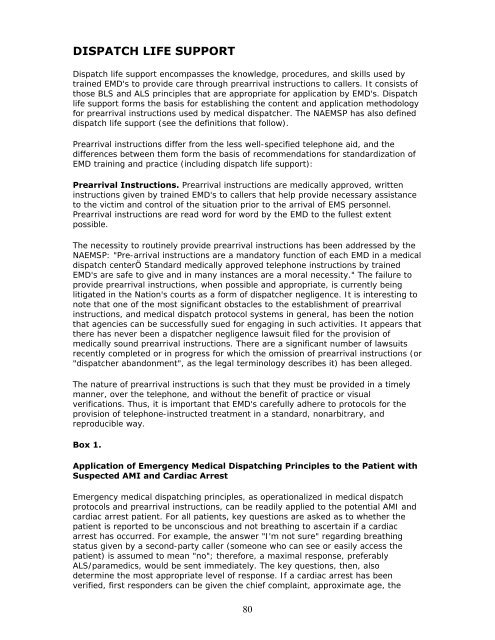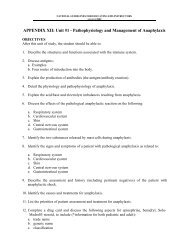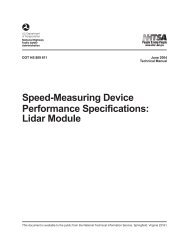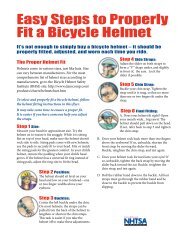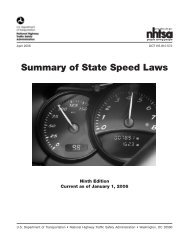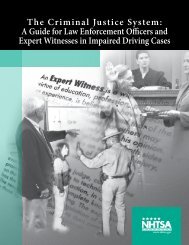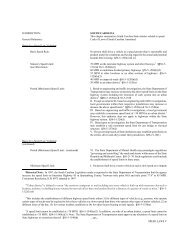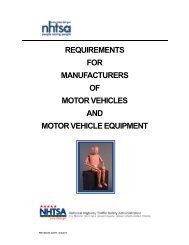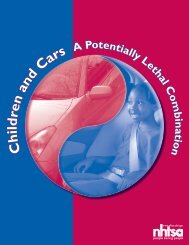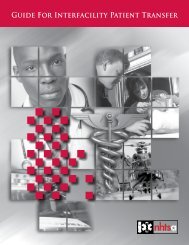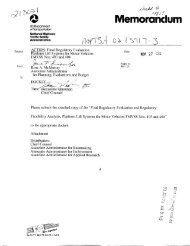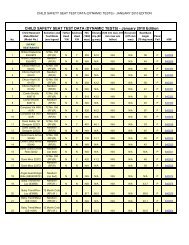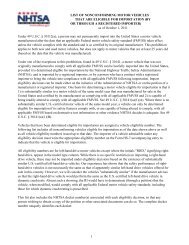Standard Practice for Emergency Medical Dispatch ... - NHTSA
Standard Practice for Emergency Medical Dispatch ... - NHTSA
Standard Practice for Emergency Medical Dispatch ... - NHTSA
You also want an ePaper? Increase the reach of your titles
YUMPU automatically turns print PDFs into web optimized ePapers that Google loves.
DISPATCH LIFE SUPPORT<br />
<strong>Dispatch</strong> life support encompasses the knowledge, procedures, and skills used by<br />
trained EMD's to provide care through prearrival instructions to callers. It consists of<br />
those BLS and ALS principles that are appropriate <strong>for</strong> application by EMD's. <strong>Dispatch</strong><br />
life support <strong>for</strong>ms the basis <strong>for</strong> establishing the content and application methodology<br />
<strong>for</strong> prearrival instructions used by medical dispatcher. The NAEMSP has also defined<br />
dispatch life support (see the definitions that follow).<br />
Prearrival instructions differ from the less well-specified telephone aid, and the<br />
differences between them <strong>for</strong>m the basis of recommendations <strong>for</strong> standardization of<br />
EMD training and practice (including dispatch life support):<br />
Prearrival Instructions. Prearrival instructions are medically approved, written<br />
instructions given by trained EMD's to callers that help provide necessary assistance<br />
to the victim and control of the situation prior to the arrival of EMS personnel.<br />
Prearrival instructions are read word <strong>for</strong> word by the EMD to the fullest extent<br />
possible.<br />
The necessity to routinely provide prearrival instructions has been addressed by the<br />
NAEMSP: "Pre-arrival instructions are a mandatory function of each EMD in a medical<br />
dispatch centerÖ <strong>Standard</strong> medically approved telephone instructions by trained<br />
EMD's are safe to give and in many instances are a moral necessity." The failure to<br />
provide prearrival instructions, when possible and appropriate, is currently being<br />
litigated in the Nation's courts as a <strong>for</strong>m of dispatcher negligence. It is interesting to<br />
note that one of the most significant obstacles to the establishment of prearrival<br />
instructions, and medical dispatch protocol systems in general, has been the notion<br />
that agencies can be successfully sued <strong>for</strong> engaging in such activities. It appears that<br />
there has never been a dispatcher negligence lawsuit filed <strong>for</strong> the provision of<br />
medically sound prearrival instructions. There are a significant number of lawsuits<br />
recently completed or in progress <strong>for</strong> which the omission of prearrival instructions (or<br />
"dispatcher abandonment", as the legal terminology describes it) has been alleged.<br />
The nature of prearrival instructions is such that they must be provided in a timely<br />
manner, over the telephone, and without the benefit of practice or visual<br />
verifications. Thus, it is important that EMD's carefully adhere to protocols <strong>for</strong> the<br />
provision of telephone-instructed treatment in a standard, nonarbitrary, and<br />
reproducible way.<br />
Box 1.<br />
Application of <strong>Emergency</strong> <strong>Medical</strong> <strong>Dispatch</strong>ing Principles to the Patient with<br />
Suspected AMI and Cardiac Arrest<br />
<strong>Emergency</strong> medical dispatching principles, as operationalized in medical dispatch<br />
protocols and prearrival instructions, can be readily applied to the potential AMI and<br />
cardiac arrest patient. For all patients, key questions are asked as to whether the<br />
patient is reported to be unconscious and not breathing to ascertain if a cardiac<br />
arrest has occurred. For example, the answer "I'm not sure" regarding breathing<br />
status given by a second-party caller (someone who can see or easily access the<br />
patient) is assumed to mean "no"; there<strong>for</strong>e, a maximal response, preferably<br />
ALS/paramedics, would be sent immediately. The key questions, then, also<br />
determine the most appropriate level of response. If a cardiac arrest has been<br />
verified, first responders can be given the chief complaint, approximate age, the<br />
80


